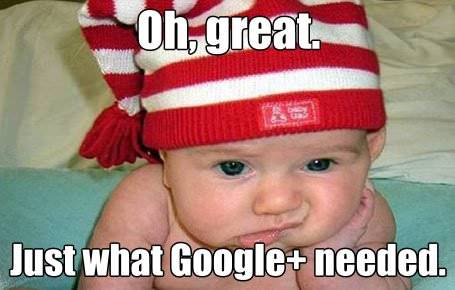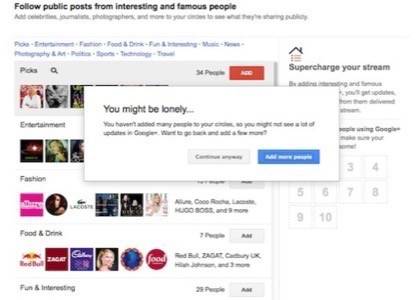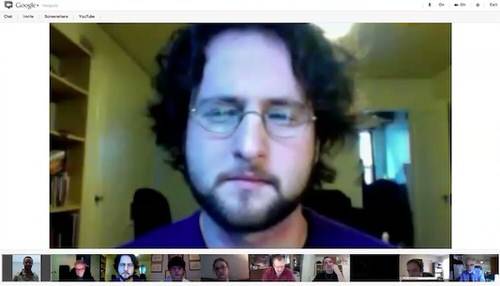It has been five months since Google+ opened to everyone. 90 million users have at least turned it on, and new Google users get Google+ automatically. It underlies all of Google now, from search to chat to maps to YouTube. It’s even on the sacrosanct front page of Google.com. But what is it?

Jon Stewart got hearty laughs when he called it “Google+. Or, as all Gmail users know it, ‘What the f— is that thing up there? Is there any way I can turn that off?'” That red box doesn’t mean anything yet. By independent measures, Google+ appears to be a young, tech-y dude fest. If Google+ wants to be a more vibrant community, there are a few things it needs to do now.
Let Users Define It
The value of Google+ for Google is clear: it’s an identity service for search. It puts people, places and things into Web search in a more meaningful way by creating a full-fledged profile for them, instead of just robotically ranking their Web pages.
It also gives the people behind those profiles more control over how they appear in search. By indexing intentional interactions instead of just hyperlinks, Google hopes to make its search results more meaningful, useful and targeted, and thus more profitable.

But what is its value for users? Explaining the role of Google+ in search won’t help most people. Google tries to bring users on board with its own copy, all about “cool people” and “cool stuff,” but how “cool” does that really sound? Google needs to explain that joining Google+ is not just making yourself into a feature of search.
More Community-Focused Features
At the moment, most of Google+’s features are designed for adding people, pages and content. New users are thrust into a process of finding people to follow, first by importing their contacts, then by searching for circle-mates, then by “supercharg[ing their] stream” with topically curated circles. If you don’t want any of that, you’re warned that “You might be lonely…”
You can continue anyway, but then all you see is “Hot on Google+,” the posts that are most popular amongst this mysterious community where you don’t know anyone.

Popular content is not enough to define what a community is about. Those of us who are active on Google+ know that people spend a lot of energy there talking about Google+. Effectively, we’re asking the question, “What are we doing here?”
For a community to grow, it needs to find its own answer to that question. Google’s marketing copy will not do the job. At the Hypothes.is Reputation Workshop last week, we heard from Reddit‘s Erik Martin and Stack Overflow/Stack Exchange co-founder Jeff Atwood, people responsible for two mind-blowingly successful online communities. They couldn’t stress this enough.
Google+ Needs More “Meta”
“Give the community the ability to play,” Martin said. Reddit lets users edit the CSS of their subreddits, so they can make each community within the whole site feel like home. For example, members of the NBA subreddit can display the logo of their favorite team next to their user name. To make Google+ users feel at home, Google has to give them the ability to renovate, or at least rearrange the furniture.
But more importantly, members of a new online community (and new members of any online community) need a place to figure out what they’re doing. Atwood insisted upon the importance of the Meta section at Stack Overflow, where users can hash out the way they want the site to work, taking that meta-talk out of the main channels. This solves the talking-about-Google+ problem.
But it does more than that. It gives Google+ community managers a dedicated forum for talking to engaged users about the purpose of the social network. It makes it easier to find people with the same vision for the site, better than just searching randomly for them or having hashtag conversations.
People don’t have conversations with feedback forms, and they don’t know how to effectively approach Google staff out of the blue and make suggestions. In the Meta area, users can learn the ropes from each other and come up with great ideas, and Google+ moderators can listen and incorporate that work.

The First Thing Users See
This should be the first thing new users see. Not “upload your email contacts,” not “follow the Fashion circle.” What are we doing here? When a new Google+ user logs in for the first time, she should see a bunch of her peers saying, “Here’s what we’re doing. Want to get involved?”
There is a vibrant, user-created culture starting to brew on Google+, it’s just hard for users to get involved with it. Feel like organizing an “unofficial” Google+ Film Festival?. It’s already happening. Google+ should make those efforts front and center. If it’s ever going to be a self-sustaining place for people to hang out, it needs to give its users a place to play.
Are you using Google+? What do you do there? Feel free to share links in the comments.










